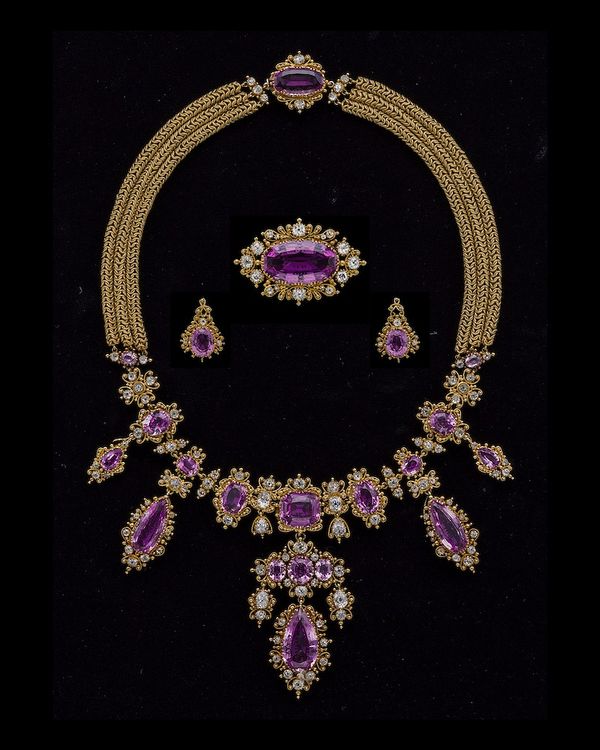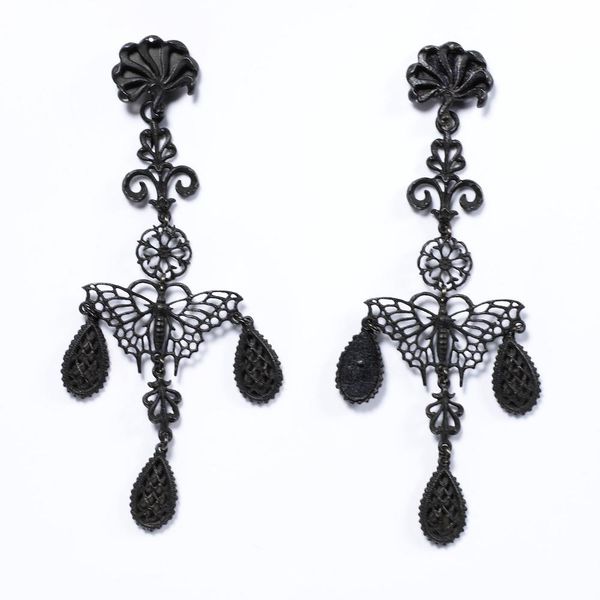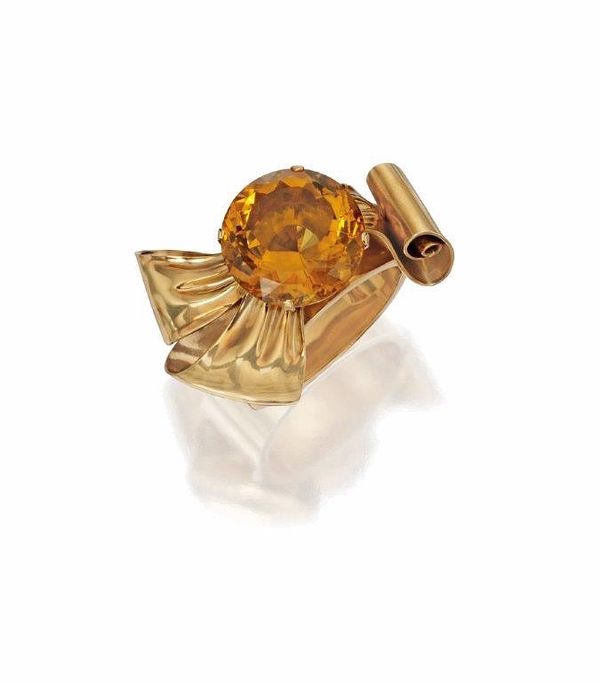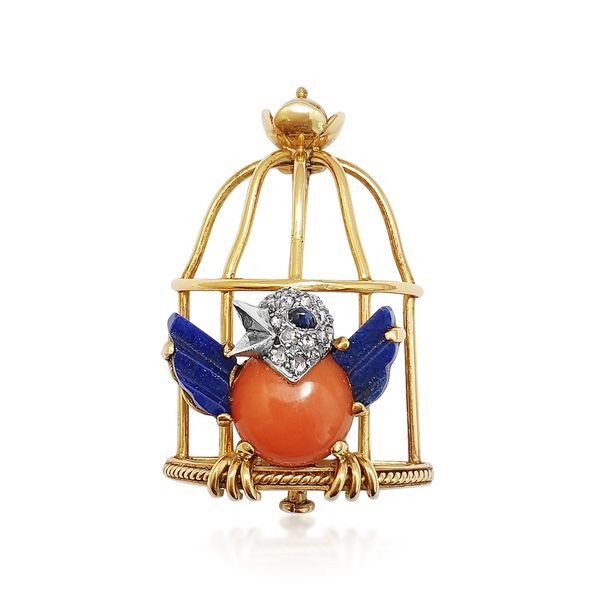Cartier, Liberated Bird, 1944. Courtesy of Revival Jewels, Singapore.
Written by Vivienne Becker
Through its multi-millennia-long history, jewelry has been shaped by major global shifts and crises, by war, revolution, depression, and invasion, by social, political and financial upheaval, by fortunes and empires made and lost. Across cultures and civilizations, across time, gems and jewels have traditionally offered a safe store of wealth and the most portable form of wealth at that; jewelry history is full of stories of gems sewn into bodices or hems of garments, secreted in hidden pockets, smuggled across borders. Legend has it that the Grand Duchess Vladimir’s astonishing jewels were carried out of Revolutionary Russia in a battered Gladstone bag, and the legendary gem-merchant, Alexandre Reza, used to tell how his mother, escaping the Bolsheviks, hid her husband’s remaining jewelry stock in her baby son’s chamber pot. Needless to say the border guards didn’t check.

Pink topaz and gold cannetille parure, c. 1820. Courtesy of Albion Art, Tokyo.
Many of the seismic events that affected jewelry in the past revolved around cross-cultural pollination, from trade, globalization, or colonization. When Byzantium, renamed Constantinople, became the capital of the Eastern Roman Empire, it brought a wealth of gold, gems, pearls and craft-skills to the West; when the Conquistadors explored and plundered the New World they brought emeralds to Europe, and circuitously to Mughal India, giving us some of the most treasured, historic jeweled works of art, and setting in motion a chain of East-West influences that, most notably, enriched 1920s and 30s jewelry design, including Tutti Frutti.
Jewelry history is full of stories of gems sewn into bodices or hems of garments, secreted in hidden pockets, smuggled across borders.
In wartime, when precious metals become scarce, jewelers have had to find new materials or ingenious ways to eke out limited resources. Necessity being the mother of invention, gold filigree work, called cannetille, little coils and spirals of gold wire, named after the embroidery of the time, became fashionable during and after the Napoleonic wars in the early 19th century. Around the same time, in Germany, the delicate, lacy black ironwork, known as Berlin Iron, became both the height of fashion and a sign of patriotism. Neoclassic and Gothic-revival in style, this iron jewelry had been made by the Prussian Iron Foundry since 1804, but during the Prussian war of liberation, against Napoleon, in 1813, women were invited to donate their gold jewelry to the war effort in exchange for iron jewelry. It was often inscribed “Gold gab ich für Eisen”—I gave gold for iron.

Siméon Pierre Devaranne, Berlin Iron pair of earrings, c. 1815-1851. © Victoria and Albert Museum, London.
Perhaps the best known example of wartime patriotic jewelry is Cartier’s Caged Bird brooch—a little bird, constructed from lapis, coral, and white gold, the colors of the French flag, inside a yellow gold cage, was conceived by Cartier’s directrice of High Jewelry, Jeanne Toussaint, in 1942 as a poetic protest against Nazi occupation. Immediately after liberation, Cartier presented the same bird in an opened cage. Elsewhere in World War II, as platinum, classified as a strategic material, was banned for all non-military use, gold, even though in relatively short supply, was back in fashion, augmented with copper to make rose gold, and rolled or stamped into shapes that gave the impression of massive magnificence. Huge chunks of less-valuable stones, aquamarines, citrines, peridots added to their much-needed exuberance. Yet this Retro or Cocktail style was generated by much more than war; it emerged in the late 1930s, showcased at the World’s Fairs, in Paris in 1937 and New York in 1939, both themed around a vision of the modern world and the future.
For it is not only disasters, wars, or crises that change the course of jewelry design and manufacture. The quest for modernity in each age, sweeping social changes and lifestyles, or momentous scientific and technological innovations—the machine, travel, speed, and flight—that shaped the 20th century also influenced jewelry design. Modernist artist-jewelers of the 1920s turned their backs on historicism, on well-travelled themes, flora and fauna, to capture the spirit of the machine age, drawing on global and artistic influences, such as African art and Cubism.

Paul Flato, A Retro Gold and Citrine Bangle Bracelet. Neil Lane Couture. Formerly from the estate of Nelson R. Rockefeller.
All of this was brewing at a time of financial instability following the Depression—just as a watershed moment in the decorative arts had arrived unexpectedly with the Ballets Russes in Paris in 1910. The first performance of Schéhérazade delivered the shock of the new: the Orientalism, pulsating colors, sensuality, and stylization jolted Parisian audiences out of the pale, leisured cocoon of the Belle Époque into the 20th century into the looming cacophony of war, social, geopolitical, and financial change.
There’s also a strong emotional element to the appeal of jewels and gems in troubled times.
While it’s clear that in times of crisis jewelry can become a store of wealth, a hard asset, and a form of capital, there’s also a strong emotional element to the appeal of jewels and gems in troubled times. The deep emotional tie is as much a part of the jewel‘s make-up as its intrinsic value. At the turn of the Millennium, faced with the unknown, fears of a predicted technological disaster, with anxiety mingled with excitement, the diamond once again triumphed, lighting the way forward into the 21st century, with its celebratory sparkle, but also as an emblem of continuity, security and invincibility. In the early 2000s, there was a massive upsurge in amuletic jewelry, a revival of charms and talismans, spiritually-imbued personal possessions, offering us a semblance of control over forces beyond our control, a sense of protection and reassurance—tapping into the earliest, most powerful origins of the jewel. So whatever the underlying reasons, financial or emotional, or the mix of both that is unique to gems, the scene is always set for the universe of jewels to endure.

Recommended Reading
Vivienne Becker Meets Fabio Salini >
Vivienne Becker Meets Shaun Leane >
